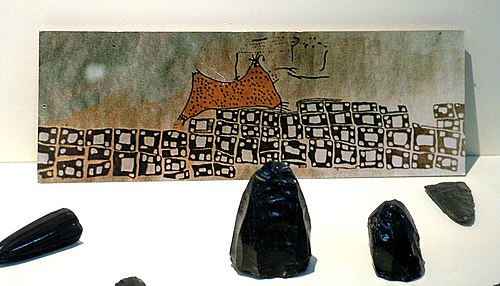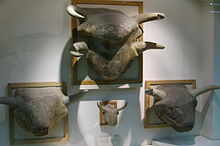Çatalhöyük
Çatalhöyük, also known as Çatal Höyük, Çatal Hüyük or Catal Hüyük (pronunciation in Turkish: /t͡ʃaˈtaɫhœjyc/; from Turkish çatal: "fork", and höyük: "mound"), is an ancient settlement from the Neolithic and Chalcolithic periods, and the largest and best-preserved urban complex from the Neolithic period in the Near East. At its height this settlement covered 13 hectares. In turn, it is considered, according to some historians, the first village in the world.
Çatalhöyük is located in the south of the Anatolian peninsula, on the Konya plain, near the current city of Konya (former Iconium) and approximately 140 km from the Hasan Dağ volcano in Turkey.
A channel of the Çarşamba river used to flow between the two mounds that make up the site, built on alluvial clay soils that could have been favorable for early agriculture. The one located to the east could reach a height of 20 meters above the plain in the last moments of Neolithic occupation. The one to the west forms a minor elevation and there is also a Byzantine site a few hundred meters to the east. Settlements from prehistoric times were abandoned before the Bronze Age. In its lower (and older) layers, the site dates from around the middle of the VIII millennium BC. C. and the most recent ones from around 5700 B.C. C. Although, according to the "Lyon School", it belongs to periods 4 and 5 of the prehistory of the Near East (6600-5600 BC).
The development of this civilization was abruptly interrupted around 5700 BC. C. by a great fire, which cooked the adobe and allowed walls of up to three meters to remain standing. Most of the settlement was destroyed or abandoned.
In 2012, UNESCO included it in the list of World Heritage Sites.
Finding
Initially discovered in 1958, the Çatalhöyük site did not attract world attention until excavations by James Mellaart, carried out between 1961 and 1965, which revealed that this region of Anatolia was a focus of advanced culture during the period Neolithic. But Mellaart was expelled from Turkey because of his involvement in the Dorak affair, having published drawings of supposedly important Bronze Age artifacts, which later disappeared (see Pearson and Connor, below).
After the scandal, the site lay dormant until September 12, 1993, when investigations began led by Ian Hodder, then at Cambridge University. Such works are among the most ambitious excavation projects underway according to, among others, Colin Renfrew. In addition to the extensive use of the archaeological method, psychological and artistic interpretations of the symbolism of the wall paintings are also sought. Hodder, a former Mellaart disciple, chose the site as the world's first real trial of his then-controversial academic theory of post-processual archaeology. The success of the excavation has validated the post-processing method as a new approach that has created a school.
The site
According to some authors, the entire settlement of Çatalhöyük would be made up of buildings for residential use, without the existence of public buildings being irrefutably established. For others, the fact that the best and most exuberant wall paintings are in the largest premises leads them to define these as ritual places. But the purpose of these ornately decorated rooms is unclear.
The population of the eastern hill has been estimated to be over 10,000, but the total population would likely vary throughout the town's history. An average of between 5,000 and 8,000 inhabitants would be a reasonable estimate.
The population lived in rectangular houses built with adobe, attached, without streets or passages between them, huddled together as if they formed a honeycomb. Access to the houses was through the roofs, walking on them as if they were streets, using interior and exterior stairs to communicate the different levels. The walls were also made of adobe and to form the roof, wooden beams and tamped mud were used on plant mats. Roof openings also served as the only source of ventilation, providing fresh air and allowing smoke from open kitchens and fireplaces to escape.
Since the houses were on a party wall, a kind of defensive wall was configured towards the outside, without openings. This must have been enough to safeguard its inhabitants from attacks, since no signs of fighting have been found at the site.
All the interiors of the houses are plastered with a very smooth finish and are characterized by the absence of right angles. They generally consist of a common room of 20-25 m² and some adjoining rooms. The main room has benches and platforms for sitting and sleeping, a rectangular hearth raised off the ground and an oven for making bread, serving a wide range of domestic activities. The ancillary rooms were used as storerooms and were accessed from the main hall by low openings.
The rooms were kept scrupulously clean: archaeologists have identified very little rubbish or debris inside the buildings, but the rubbish heaps outside the ruins contain sewage and food remains, as well as significant amounts of vegetable ash. Possibly when the weather was good many of the daily activities would take place on the terraces, which could thus have formed an open space similar to a square. Apparently, in late times, large communal ovens were built on the terraces. Over the centuries the houses were renovated through partial demolitions and reconstructions on a foundation formed by rubble, which caused the growth of the hill. Up to 18 levels of settlements have been discovered.
Culture and rituals
The inhabitants of Çatalhöyük buried their dead inside the village: human remains have been found in holes under the floors of the rooms, especially under the fireplaces, the platforms of the main rooms and the beds. The bodies were folded as far as possible and often placed in baskets or wrapped in red mats. Disarticulated bones in some graves suggest that the bodies may have been exposed to the open air for a time before being collected and buried. In certain cases, the tombs have been removed and the heads of the individuals separated from the skeleton, and these skulls may have been used in a ritual manner, since some have been found in other areas of the community. Several skulls were plastered and painted with ocher to recreate the human face, a custom more characteristic of Neolithic sites in Syria and Jericho than of nearby sites.
Remains of up to forty buildings have been found (distributed among nine of the population levels) that seem to be dedicated to tombs and sanctuaries. On the walls of these sanctuaries were found frescoes showing hunting scenes, ritual dances, men with erect penises, representations in red of the now extinct aurochs (Bos primigenius or wild bull) and deer, as well as vultures swooping down on headless figures.
A Level VII fresco purporting to represent the village, with the twin peaks of the Hasan Daği volcano in the background, is often cited as the "oldest map in the world" and the first landscape painting from 6600 BC. But some archaeologists question that interpretation: Stephanie Meece, for her part, argues that the fresco is more like a leopard's skin than a volcano, a decorative geometric design than a map.
Modeled in relief, on the walls of these "sanctuaries" There are female characters (women in a position to give birth and the figure of the "Mother Goddess" dominating animals), animal heads, such as leopards, goats, bears and, standing out among all of them, the clay bucraniums provided with real horns of bulls (bottom left). The characteristic female figurines made of clay or stone discovered throughout the settlement, inside and outside its walls, including inside containers for storing grain, belong to the upper levels of the site (the most recent).
Although according to some researchers no clearly identifiable temples have yet been found, it is indisputable that the tombs, murals and figurines suggest that the population of Çatalhöyük had a complex religion, rich in symbology and that they met in certain rooms, abundant in such finds, which would be chapels or meeting areas.
Economy and society
It seems that the inhabitants of Çatalhöyük lived in a relatively egalitarian way, without any evidence of the existence of social classes, since until now no houses with differentiated characteristics have been found (belonging to royalty or the religious hierarchy, for example). The most recent research also reveals little social differentiation based on gender, with both men and women receiving an equal diet and apparently having similar relative social status, a fact established as typical of Paleolithic cultures.
The most common illnesses among the settlement's population were anemia, arthritis, and malaria, endemic to the region due to nearby swamps. Life expectancy would be about 34 years for men and 29 for women, although some individuals could reach 60.
In the upper levels of the site it is evident that the inhabitants of Çatalhöyük were gaining knowledge in agriculture and in the domestication of animals. Cereals such as wheat and barley were grown, as well as peas, chickpeas, lentils and flax, while fruits such as almonds, pistachios and apples were collected from the trees on the surrounding hills. Vegetable oils were extracted from plants and seeds, as well as a kind of beer. Although most animal protein came from fishing and hunting (deer, wild boar and onager), sheep had already been domesticated and evidence suggests that bovids were beginning to be as well.
The elaboration of ceramics and the manufacture of obsidian utensils (obtained in the Hasan Daği volcano) were flourishing industries, which allowed them to maintain commercial relations with distant points of the Anatolian peninsula, obtaining in exchange shells from the Mediterranean and flint from Syria. They also worked with wood and copper, the craftsmen of Çatalhöyük being experts in their foundry, which would be the oldest example of metallurgical activity in the Near East. The list of products manufactured by these artisans would include obsidian or flint arrowheads, spears and daggers, stone maces, stone and fired clay figurines, textile garments, bowls and other wooden or ceramic containers, and jewelry made from pearls. or copper.
Thanks to the dry climate of this area, remains of excellent quality fabrics have been preserved. Clay seals have also been found to stamp the costumes with various drawings, whose design bears many similarities with those of current Turkish carpets.
Religion
A distinctive feature of Çatalhöyük is its female figurines: Mellaart argued that these figurines, painstakingly rendered in materials as diverse as marble, blue and brown limestone, schist, calcite, basalt, alabaster, and clay, represented a female deity of the Mother Goddess type.. Although there was also a male god, the number of female figurines was much higher and this god does not actually appear until after level VI, 18 levels having been identified to date. The figurines were found primarily in areas Mellaart considered to be chapels.
The imposing goddess seated on a throne flanked by two felines (right illustration) was found inside a container used to store grain, which suggested to Mellaart that it was a deity who would ensure the harvest or protect stored provisions.
While Mellaart excavated nearly two hundred buildings in four seasons, Ian Hodder currently spends an entire season excavating a single building. During 2004 and 2005 Hodder and his team began to believe that Mellaart's model of a sign culture matriarchal was false. Having found only one figurine similar to the model of the Mother Goddess that Mellaart advocated, among the large number of them unearthed, Hodder decided that the site did not offer sufficient indications to establish whether it was a matriarchal or patriarchal culture, but rather pointed towards a relatively egalitarian society.
Professor Lynn Meskell states, in support of this theory, that while in the initial excavations only 200 figurines were found, new work has unearthed 2000, of which many are of animals and only 5% of the figurines are of women.
Contenido relacionado
German Dehesa
Claudius Ptolemy
Sahara desert






